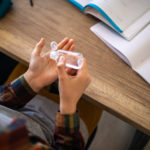By Mark Wright, OD, FCOVD,
and Carole Burns, OD, FCOVD

Jan. 27, 2021
The COVID-19 virus poses dangers to our health, but there are other, less obvious dangers that also may negatively impact us. There has been an uptick in injury to children’s eyes from hand sanitizer. Here is how to educate your patients on what they need to do to keep their children’s eyes safe.
The Problem
Hand sanitizer is hurting more children’s eyes, some severely.
Hand hygiene is a key way to prevent the spread of Covid-19. With the wide use of alcohol-based hand sanitizer, however, there has been an increase in chemical injuries to children who have accidentally gotten sanitizer in their eyes, according to a French study. Here is the problem and the solution. Let’s start first with the numbers.
• There were seven times more cases of children getting hand sanitizer in their eyes between April 1 and August 24, 2020, compared with the same period a year earlier.
• Hand sanitizer accidents accounted for just 1.3 percent of all chemical eye exposure incidents in children in 2019, then increased to 9.9 percent in 2020.
• Most cases were mild, however, two severe cases required corneal surgery.
• All hospitalization cases of getting hand sanitizer in the eyes were children under the age of four.
• The highest risk to children comes from sanitization dispensers in public places.
The height of the sanitizer dispensers in public places seems to be a part of the problem. Most gel dispensers are placed at three feet from the floor. Three feet is waist level for most adults, but eye level for children. This gives two different methods of transmission of the sanitizer into the child’s eyes: hand-to-eye and splashing.
Other Articles to Explore
What Can We Do?
Take these four steps to reduce the risk of children accidentally getting hand sanitizer in their eyes.
1. Educate your adult patients about the danger and what to do.
• You can do this with signage in the office, on your website and with your social media.
• Place “CAUTION” signs next to the sanitizer dispensers in your office.
• Educate people if a child’s eyes are exposed to hand sanitizer they need to be seen by a medical professional quickly.
2. Teach and train children how to use hand sanitizers.
3. Have separate dispensers for children at lower heights.
4. Make sure you have a flushing kit and a written protocol prepared for anyone who has this issue.
Conclusion
Even though we’ve focused on children in this article, the same risk exists for adults.
You want your practice to be known in the community as the place to come for eye education and eye issues. Spreading this information will help establish that reputation. `


























